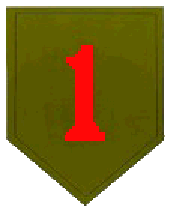The Story of the American Expeditionary Forces |
 First Division |
Lafayette, We are Here!
|

 "Vive l'Amèrique!" shouted the little boy standing at the edge of a Boulogne
pier as he waved his arms at the steamer passing into port.
 The arrival of the rest of the American Expeditionary Force would be less theatrical. While the First Division was undergoing heavy training and Pershing was shaking up and rebuilding his command, the Second Division began arriving in late August. The Second, in total about 25,000 men, rather trickled into France. In March, April and May of 1918 they were still arriving. This again was mainly due to the experienced men being transferred to train other units and being replaced piecemeal by new recruits and conscripts still coming in from the States. Once in port, the doughboys were loaded into railroad boxcars - large enough for 40 men or eight horses - and sent off to their designated training areas. The trip sometimes took a few days and was almost always followed by a long hike to camp. For the divisions that arrived in the late fall and winter, the French excursion was a swift awakening to the wet, cold conditions they would slog through for months. Meanwhile, French officials were becoming impatient for the doughboys to actually get into the fight.  In September, the 26th Division was on French shores and then in October, the 42nd (Rainbow) Division. Both were comprised of National Guard units, the former mainly from New England and the latter from all over the country. This ingress, too, was slow and in installments. Even regiments had to be temporarily broken apart to facilitate shipping. Part of the 26th had already been in some scraps before the entire division had completely disembarked by January 1918. Units also faced rapid command changes. Many a division, many a regiment, many a battalion found itself with a different commanding officer than it had trained under in the States. Again, the situation can be marked down in part to the shifting of experienced officers, but a large reason for it was the quick assessment of the officers' real abilities. Pershing and his staff were no respecters of persons when it came to weeding out long-time officers they deemed unfit for the warfare they faced. The Second Division, made up of Army, Navy and Marines, was completely reorganized in France. Three other divisions, or at least division commands, began arriving on French shores before the end of 1917. The 32nd, a National Guard division, came out of Michigan and Wisconsin. The 41st, another NG division, was comprised of units from all over the West and became the 1st Depot Division. And then there was the 93rd National Army Division, a so-called "colored" unit. The U.S. military was, of course, not integrated, and some generals had already made it very clear they did not want to command black soldiers. The British, too, stated to Pershing that training with the African-Americans would be bad for morale. The French had no such hesitations and welcomed the chance to fill their lines with the four infantry regiments. Almost as soon as the division command arrived in January, Pershing executed a rare break from his firm stand against American soldiers fighting under foreign command and sent the 93rd to the French. This was ostensibly on a temporary basis as replacements. They would be with the French troops for the rest of the war. Residents of crowded ports like Brest became accustomed to the sight of Yankees marching off the ships and the American stevedores, white and black side-by-side, unloading supplies. So common was the sight of disembarking U.S. soldiers after a time that the reception by residents became quite lackadaisical and inclined to self-interest. Prices, already bloated by war, shot up. Hospitality businesses thrived. It would not be long before the ports were well known as havens for prostitutes and the accompanying diseases.  Sources and Thanks:Photos from Ray Mentzer and Herb Stickel. The author found these works useful in preparing this article and recommends them:
|
To find other Doughboy Features visit our |
Membership Information  Click on Icon |
For further information on the events of 1914-1918
visit the homepage of |
Michael E. Hanlon (medwardh@hotmail.com) regarding content,
or toMike Iavarone (mikei01@execpc.com) regarding form and function.
Original artwork & copy; © 1998-2000, The Great War Society